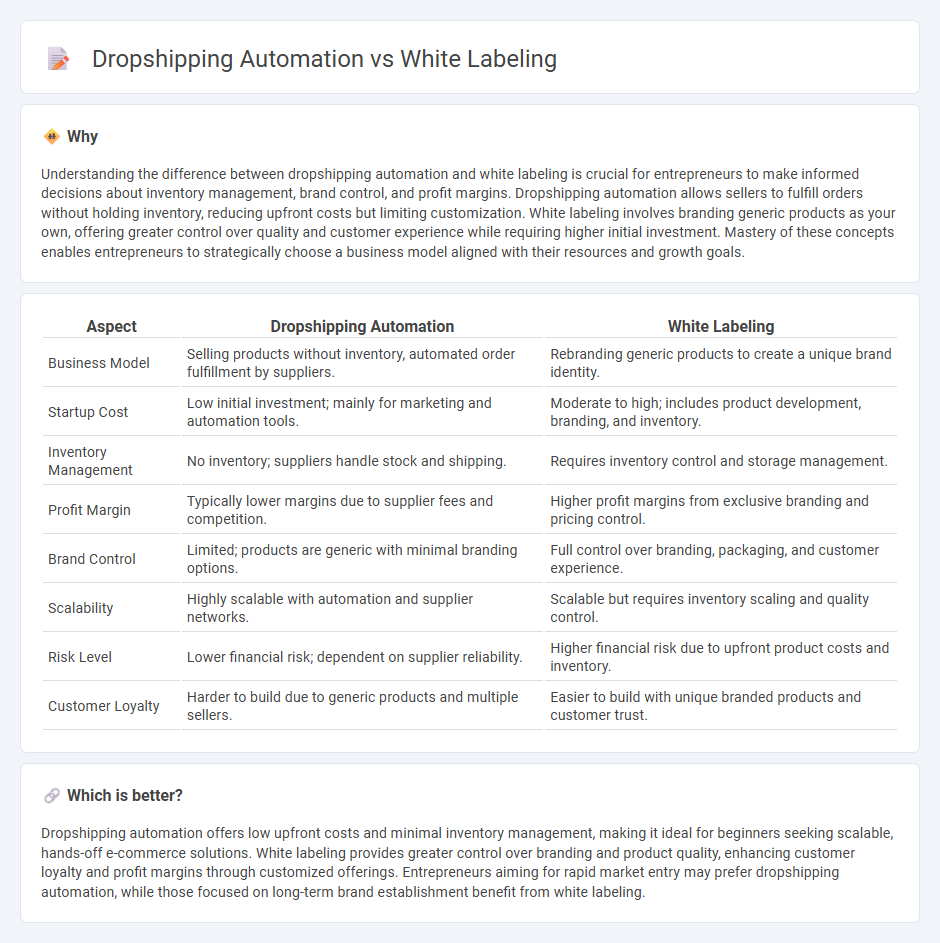
Dropshipping automation enables entrepreneurs to sell products without holding inventory by automating order processing and supplier communication, reducing upfront costs and operational workload. White labeling involves branding generic products as your own, offering greater control over product quality and customer experience while often requiring higher investment and inventory management. Explore the key differences and benefits of dropshipping automation versus white labeling to determine the best strategy for your entrepreneurial journey.
Why it is important
Understanding the difference between dropshipping automation and white labeling is crucial for entrepreneurs to make informed decisions about inventory management, brand control, and profit margins. Dropshipping automation allows sellers to fulfill orders without holding inventory, reducing upfront costs but limiting customization. White labeling involves branding generic products as your own, offering greater control over quality and customer experience while requiring higher initial investment. Mastery of these concepts enables entrepreneurs to strategically choose a business model aligned with their resources and growth goals.
Comparison Table
| Aspect | Dropshipping Automation | White Labeling |
|---|---|---|
| Business Model | Selling products without inventory, automated order fulfillment by suppliers. | Rebranding generic products to create a unique brand identity. |
| Startup Cost | Low initial investment; mainly for marketing and automation tools. | Moderate to high; includes product development, branding, and inventory. |
| Inventory Management | No inventory; suppliers handle stock and shipping. | Requires inventory control and storage management. |
| Profit Margin | Typically lower margins due to supplier fees and competition. | Higher profit margins from exclusive branding and pricing control. |
| Brand Control | Limited; products are generic with minimal branding options. | Full control over branding, packaging, and customer experience. |
| Scalability | Highly scalable with automation and supplier networks. | Scalable but requires inventory scaling and quality control. |
| Risk Level | Lower financial risk; dependent on supplier reliability. | Higher financial risk due to upfront product costs and inventory. |
| Customer Loyalty | Harder to build due to generic products and multiple sellers. | Easier to build with unique branded products and customer trust. |
Which is better?
Dropshipping automation offers low upfront costs and minimal inventory management, making it ideal for beginners seeking scalable, hands-off e-commerce solutions. White labeling provides greater control over branding and product quality, enhancing customer loyalty and profit margins through customized offerings. Entrepreneurs aiming for rapid market entry may prefer dropshipping automation, while those focused on long-term brand establishment benefit from white labeling.
Connection
Dropshipping automation streamlines inventory management and order fulfillment, enabling entrepreneurs to efficiently scale their online businesses without holding physical stock. White labeling complements this process by allowing sellers to brand generic products as their own, enhancing customer loyalty and market differentiation. Together, these strategies reduce operational complexity and foster scalable, brand-centric ecommerce models.
Key Terms
Private Labeling
Private labeling involves creating and branding your own unique products, offering higher profit margins and greater control over quality compared to dropshipping, which relies on third-party inventory and fulfillment. Automated private labeling systems streamline product design, manufacturing coordination, and inventory management, enhancing scalability and brand consistency. Explore how private labeling automation transforms e-commerce strategies and enables sustainable business growth.
Fulfillment
White labeling allows businesses to customize and brand products before fulfillment, ensuring a unique customer experience with greater control over inventory management. Dropshipping automation streamlines order processing by directly linking suppliers and retailers, minimizing inventory risks and shipping responsibilities. Explore the key differences in fulfillment strategies to optimize your e-commerce operations.
Inventory Management
White labeling requires precise inventory management to maintain brand consistency and avoid stockouts, often involving direct control over product storage and fulfillment. Dropshipping automation relies on seamless integration with suppliers' inventory systems to ensure real-time stock updates and minimize order errors. Explore more insights on optimizing inventory strategies for both models to enhance operational efficiency.
Source and External Links
What Is White Labeling and What Are Its Benefits - White labeling is a business practice where a company uses another company's product or service and applies its own branding to it, allowing quick market entry with reduced costs, increased brand exposure, and a competitive advantage.
What is White Labeling and How Does It Work? - Squarespace - White labeling involves a manufacturer creating a generic product, which businesses then rebrand, market, and sell as their own, enabling efficient product expansion without the need for development.
What Are White Label Products? (2025) - Shopify - White label products are generic items produced by one company and sold under multiple brand names, helping businesses offer diverse products cost-effectively while distinguishing from private label or print-on-demand models.
 dowidth.com
dowidth.com